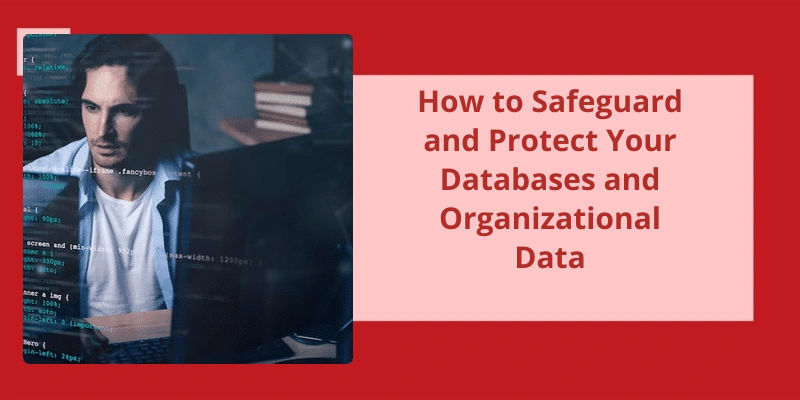Protecting databases and other critical organizational data has become a top priority for businesses of all sizes. With the increase in cyber attacks and data breaches, it’s vital for organizations to implement effective safeguards to secure their data. From financial records to personal customer information, data is the lifeblood of any organization. To ensure it’s safety, data safeguards are put in place, such as encryption, firewalls, and backup systems. Advanced security measures are essential for businesses to protect themselves from external threats such as malware, hacking attacks, viruses, and cyber-criminal activities. There are various levels of data protection, and choosing the appropriate measures to secure organizational data is crucial for business success. Overall, safeguarding data is a continuous process, and organizations must remain vigilant to stay ahead of potential threats.
How Do You Protect Confidential Information in a Database?
Protecting confidential information in a database is crucial for any organization. The first and perhaps most obvious way to ensure confidentiality is to restrict access to the data. Access should only be granted to those individuals who’ve clearance and a valid reason to access the data. This is best done through a well-defined access control system that restricts access to specific individuals, allowing them only to access the required information on a need-to-know basis.
Another effective method of ensuring confidentiality is encryption. By encrypting data, organizations can ensure that even if a breach occurs, the data will be difficult to access since it will be in an unreadable format without the decryption key. It’s important to ensure that all sensitive data is encrypted, including usernames, passwords, and credit card details.
Implementing a confidentiality policy is essential to ensure that all employees are aware of their responsibilities when handling sensitive information. The policy should clearly outline what constitutes confidential information, how it should be handled, and what the consequences of breaching confidentiality are.
A data retention policy is also an essential component of ensuring confidentiality. This policy outlines how long data should be kept and when it should be destroyed. This ensures that sensitive information isn’t unnecessarily retained and reduces the risk of a data breach.
Developing and implementing a cybersecurity program is an important step in protecting confidential information. This program should focus on identifying and mitigating potential vulnerabilities in the database and ensuring that appropriate security measures are in place to prevent breaches.
Physical security measures should also be taken to ensure that only authorized personnel have access to the database. This can include surveillance cameras, access control systems, and secure storage facilities.
Finally, a non-disclosure agreement can be used to ensure that individuals who’ve access to confidential information agree to keep it confidential. This agreement outlines the consequences of breaching confidentiality and acts as a legal deterrent to prevent employees from sharing sensitive information.
The Role of Data Backups in Database Security
- Data backups are essential for ensuring the security of databases and the information they contain.
- Backups serve as a safety net in case of accidental deletion, corruption, or hacking.
- Regular backups can help minimize downtime and the risk of data loss in the event of a security breach.
- It’s important to establish a backup strategy that includes regular backups, testing, and storage in a secure location.
- Backups should also be encrypted and password-protected to prevent unauthorized access.
- Organizations should also have a disaster recovery plan in place to ensure they can quickly recover from any data breaches or other incidents.
With the ever-evolving technological advancements, ensuring robust database security has become even more critical. By employing adequate security measures, organizations can safeguard their sensitive and confidential information from cyberattacks like SQL injections, data breaches, and unauthorized access, among others. Some common examples of database security measures include access control, encryption, audit trails, vulnerability assessments, and intrusion detection, among others. In the following sections, we’ll delve deeper into these security measures and their significance in upholding database security.
What Is Database Security and Examples?
Effective database security is critical for protecting sensitive information such as financial records, customer data, and intellectual property. It involves a combination of strategies, technologies, and best practices to secure databases against unauthorized access, data breaches, malware attacks, and other types of cyber threats.
One common strategy for protecting databases is access control, which involves restricting access to databases only to authorized users. This can be achieved through a variety of means, such as password authentication, biometric verification, and multi-factor authentication. Another key strategy is encryption, which involves encoding sensitive data so that it can’t be read by unauthorized parties. This is achieved through various encryption algorithms such as AES, RSA, and SHA.
Another important aspect of database security is the capacity to monitor and audit user activity in real-time. This can help to identify suspicious activities, such as unauthorized access or attempts to steal data. To carry out this task, database security systems may use tools to monitor user activity and generate alerts in case of unusual activity.
Some examples of database security breaches include the 2017 Equifax data breach, which exposed the personal information of over 140 million consumers, and the 2013 Target data breach, which resulted in the loss of millions of customer credit card details. In both cases, the breaches were caused by a combination of poor security practices such as weak passwords, unsecured databases, and malware vulnerabilities.
When it comes to handling sensitive data, it’s crucial to ensure that proper security protocols are in place to safeguard against unauthorized access or breaches. To achieve this, there are several measures that can be taken – ranging from organizing and classifying data to implementing stronger network security. In this article, we’ll explore some of the best methods for protecting sensitive data in a database.
How Do You Secure Sensitive Data in a Database?
In todays day and age, sensitive data is more vulnerable to cyber threats than it’s ever been before. Attacks on databases have increased exponentially over the last decade, as the value of personal information and sensitive company data has grown. This presents a major challenge facing businesses and organizations of all sizes, as they need to find effective methods to protect their sensitive data in databases.
One of the most effective methods for protecting sensitive data is to organize and classify it. This is one of the most basic methods, but it’s also one of the most important. By defining different levels of sensitivity within the data and restricting access to the most sensitive subsets of data to only those employees or users who need it, a business can significantly reduce the chances of a successful cyber attack.
Another key method for protecting sensitive data is data encryption. This is the process of converting plain text or data into unreadable code that can only be decrypted by someone with the correct decryption key. By encrypting sensitive data, businesses can thwart cyber attackers who may attempt to steal data in transit or stored data.
Performing a Data Protection Impact Assessment (DPIA) is another important method for protecting sensitive data. DPIA is the process of assessing the risks associated with the storage and processing of personal data and implementing measures to mitigate these risks. This process allows businesses to understand the risks involved and strategize how to handle each risk.
This entails the process of obscuring specific data sets so that they can’t be easily identified. This enables people who don’t require private credentials to work more efficiently with data while preserving the privacy of sensitive information.
Enabling multi-factor authentication is another key method to protect sensitive data. This means having multiple verification methods to ensure that the person accessing the data is indeed authorized to do so. By incorporating two or more verification factors like a password and an SMS or email confirmation, these systems are much more secure.
Businesses or organizations should schedule regular backups of all the important data to ensure that the sensitive data is recoverable, even in the event of a cyber attack. By allowing businesses to recover lost data, they can minimize the devastating effect of data breaches and other cyber attacks.
Source: What’s the Primary Method for Protecting Sensitive Data?
Maintaining control over who’s access to sensitive information is an essential aspect of database management. There are several types of access control that can be implemented to ensure that only authorized personnel can view or manipulate sensitive data. In this article, we will explore each of these controls in detail and discuss the best practices for securing your database.
What Are the Controls of a Database?
Database management systems are a crucial component in modern-day businesses, institutions, and organizations as they help in organizing, storing and retrieving crucial information. However, one of the biggest challenges that organizations face is the threat of unauthorized access, tampering, or misuse of data stored in their databases. Therefore, the implementation of a robust database access control system is essential.
Database access control refers to the policies, procedures, and technologies implemented to restrict access to databases and their content. These measures aim to ensure that only authorized users can access the database, and they can only access the information that they require to perform their designated tasks. The purpose of access control is to prevent unauthorized access to sensitive data or resources, preserve business confidentiality, and maintain data integrity.
There are several types of database access control systems, with the most popular being Discretionary Access Control (DAC), Mandatory Access Control (MAC), Role-Based Access Control (RBAC), and Attribute-Based Access Control (ABAC). DAC allows the database owner to grant or deny access rights to specific users or user groups. MAC, on the other hand, is a more restrictive access control system, where access rights are assigned to objects or data based on sensitivity, clearance, and classification levels.
RBAC, on the other hand, assigns access rights based on the roles or job titles of users within an organization. This helps to reduce the complexity of managing access control by implementing policies that are based on predefined job roles. ABAC, on the other hand, assigns access rights based on a set of attributes that define user characteristics such as job function, geographic location, or time of day.
To ensure effectiveness, access control must focus on access to sensitive data, which is the most critical information to secure. One way of securing sensitive data is through data encryption, where the content of the database is encoded using an encryption algorithm to prevent unauthorized access. Access control also requires education to all data stakeholders, typically through awareness campaigns designed to raise awareness on the importance of data security and prevent security vulnerabilities like phishing attacks.
Database Auditing and Monitoring: This Topic Can Cover the Importance of Auditing and Monitoring Database Activity to Detect and Prevent Unauthorized Access, Suspicious Activities, and Breaches. It Can Also Discuss the Types of Auditing and Monitoring Techniques, Tools, and Best Practices to Implement in a Database Access Control System.
Database auditing and monitoring involves tracking, analyzing and safeguarding database activity to identify any unauthorized access, malicious activities, and security breaches. This practice is critical for protecting sensitive information and ensuring compliance with regulations. It involves using various techniques and tools, such as log analysis, anomaly detection, and event correlation, to provide a comprehensive view of the database environment. Implementing best practices, including least privileges, enforcing strong passwords, and limiting network exposure, can enhance the effectiveness of the database access control system.
Now that we understand that databases can be protected by copyright as a compilation, the question is how exactly can they be protected? In this article, we will explore various ways in which databases can be safeguarded to ensure their security and integrity. We will dive into the methods of database protection, including access control, encryption, data masking, and more. Let’s get started!
Can a Database Be Protected?
Additionally, database protection doesn’t extend to the individual elements or data within the database. Therefore, protecting a database as a whole doesn’t prevent individual data points from being used or extracted.
However, there are other methods for protecting databases from unauthorized access or use. One common method is through the use of access controls, such as passwords, to restrict who can view or modify the data within the database.
By encrypting the data within the database, it becomes unreadable without the proper decryption key, making it difficult for unauthorized users to access or steal the data.
Regular backups and disaster recovery plans are also important for protecting databases. Backups ensure that data isn’t lost in the event of a system failure or security breach, while disaster recovery plans help ensure that data can be quickly and efficiently recovered in the event of a catastrophic event such as a natural disaster.
Finally, it’s important for organizations to have strong data security policies and procedures in place to protect sensitive data stored within databases. This may include restricting access to the database, regularly auditing user activity, and monitoring for potential security threats.
These include access controls, encryption, regular backups and disaster recovery plans, and strong data security policies and procedures. By utilizing these methods, organizations can ensure that their valuable and sensitive data remains secure and protected.
When it comes to protecting your sensitive data, simply having a firewall or antivirus software isn’t enough. There are three critical components that organizations must consider when implementing a comprehensive data security plan. These are confidentiality, integrity, and availability, and they each play a crucial role in ensuring the safety and privacy of your data. In this article, we’ll explore these three types of data security in greater detail, discussing how they work together to safeguard your information and prevent unauthorized access or breaches.
What Are the 3 Types of Data Security?
Confidentiality refers to the protection of sensitive and confidential data from unauthorized access. This includes securing data from both intentional and accidental exposure, either internally or externally. Data thieves take advantage of weaknesses to gain access to confidential information, such as credit card numbers, personal identification numbers, and other sensitive data. Confidentiality measures can range from simple safeguards like strong passwords to more advanced techniques such as encryption, authentication, and two-factor authentication. When sensitive data is compromised, it leads to severe data breaches that can have severe legal, financial, and reputational consequences.
Integrity is the second component and refers to the accuracy and consistency of data. High-quality data is dependable, accurate, and complete, which can only be achieved by ensuring the integrity of the data. This requires investments in technology and processes that can detect data tampering and prevent unauthorized changes. Advanced techniques such as digital signatures and blockchain can also provide strong assurance that data hasn’t been tampered with. Loose control of data integrity can lead to data corruption, fraud or a breach of confidentiality.
Availability is the third and final element and refers to the accessibility of data within an organization. Data must be available to authorized users when it’s required. With the advent of new technologies like cloud computing, there’s been an increased emphasis on ensuring that data is available to users regardless of their location. Availability measures can include technologies such as redundant servers, backup and disaster recovery, and fault-tolerant systems. Additionally, measures should be in place to prevent denial-of-service attacks and other malicious activities that can disrupt data availability.
In summary, confidentiality, integrity, and availability are the three primary components of data security. Ensuring confidentiality requires protection from unauthorized access, while maintaining data integrity is essential for preserving accuracy and consistency. Finally, availability ensures that authorized users have access to data when required, regardless of their location. Without these crucial components, organizations are at risk of data breaches, cyberattacks, legal penalties, and reputational damage. It’s essential to invest in advanced technologies, such as encryption, authentication, and two-factor authentication to ensure that organizations protect their data from all forms of cyber threats.
Conclusion
In today's age of technology, safeguarding organizational data has become more critical than ever before. With the ever-increasing number of data breaches, it’s evident that databases are under constant threat. Organizations must take proactive measures to protect their data by implementing strict security measures such as access controls, firewalls, and encryption. They must also ensure that their employees are aware of the importance of data security and are trained to handle sensitive information properly. A breach not only results in financial loss, but also damages a company's reputation and customer trust.






